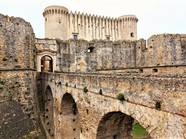Italian Americans by the Numbers – Comparative Ethnic Population Totals & Percentages
Introduction
Virtually everyone knows that the US Census Bureau conducts a census every ten years and is currently preparing for the 2010 census. Few people know the Census Bureau gathers scientific survey data about the US population annually called the American Community Survey (ACS).
The American Community Survey (ACS) is a nationwide scientific survey designed to provide a fresh look at how the population is changing between the decade censuses. The ACS collects and produces population and housing information every year instead of every ten years. This data is published online as “The American Community Survey (ACS)” at the Bureau’s website www.census.gov/acs/www/.
Recently, ACS published data summarizing the years 2005-2007, based on data collected between January 2005 and December 2007.
Part of the data collected is about “Ancestry [ethnic] Groups”. The individuals selected in the survey’s random sample are asked: “What is your ancestry or ethnic origin (For example Italian, Polish, Korean, etc)?” Aggregating the answers to these questions provides descriptive statistical characteristics for each ethnic group.
I have downloaded the data on “Americans of Italian Descent”. Needless to say there is an enormous about of data (hundreds of spreadsheet lines) for each ethnic group. Accordingly, I will make it available here in my blog on a ‘ piecemeal’ basis, in a series of articles under the general title “Italian Americans by the Numbers.”
In turn, each blog article under that general title will have a sub-title indicating the specific characteristic(s) being described in that particular article. Thus, for example, a blog title “Italian Americans by the Numbers – Education Attainment and Enrollment” will provide the ACS data on Italian American education.
In addition to ‘descriptive statistics’ of Italian Americans, I will provide ‘comparative statistics’ comparing Italian Americans to the total national population and, when of some interest, other ethnic groups. For example, the number of Italian Americans as a percentage of the whole population are compare the numbers and percentages of other ethnic groups such as German Americans, Irish…etc.
The data will be presented in a tabular/quantitative format complemented at times with charts and graphic representations of the data. I will also write narrative summary/discussion paragraphs. The numbers are interesting in themselves. But, for those with a social scientific bent, they are just a beginning. The numbers constitute the ‘observations’ that are the beginning of scientific enquires. More importantly, they are the basis for 'theory' development/verification. For example, what do the education numbers (observations) imply (theory) about Italian American attitudes about education, the future of Italian Americans in the professions, etc.
If anyone has any questions about the ACS statistics, you may place them in the comment section and I’ll respond as best I can. While I have a quantitative bent, I don’t have much formal education in social statistics. If anyone wants to collaborate on improving the presentation and making the data more widely available to the Italian American community, needless to say, I would enjoy working with them.
~~~~~~~~~~~~~~~~~~~
The Numbers
Below are the total US population, the number of Americans who identified themselves in each respective ethnic group, and the percent of the total population each group represents. For example, the total American population is 298,757,310. The total number of Americans who identified themselves on the ACS survey questioner as of German origin is 50, 496,077. Thus, 16.9% of the total American population is reported to be of German origin (i.e. 50,496,007 / 298,757,310 * 100 = 16.9%)
Discussion
What to my mind was surprising and interesting about these numbers is that the German American population was almost three times as large as the Italian American, the Irish twice as large and the English outnumber Italians by close to ten million. These numbers interest me because my personal experience and readings suggest that Italian Americans have a much higher sense of ethnic consciousness than the Germans and English. For example, the “Yahoo Italian American Directory” lists 18 Italian American organizations. Whereas the “Yahoo German American Directory” list 4 organization and there is no English Directory.
Also, my personal experiences and reading suggest that Irish Americans, similar to Italian Americans, have a high sense of ethnic consciousness and pride in their national origin, and the “Yahoo Irish American Directory” listing of 15 organizations supports this.
In short, the ACS population numbers/percentages are factual information. What they imply about the aggregate ethnic consciousness and behavior of the respective groups is speculative and would entail sociological research to be conclusive.
Nevertheless, anecdotal personal experiences and reading is not to be ignored and thought of as ‘mere speculation.’ Anecdotes are the basis of hypothesis formation in science. The anecdotes lead me to wonder why Italian consciousness is so pervasive in the country as a whole given the relatively small number of Americans of Italian descent?
As I see it: the first step in science is observations; the second, wonder; the third, hypothesis formation explaining the observations; the forth, research (more observations) to prove or disprove the hypothesis.




































i-Italy
Facebook
Google+
This work may not be reproduced, in whole or in part, without prior written permission.
Questo lavoro non può essere riprodotto, in tutto o in parte, senza permesso scritto.